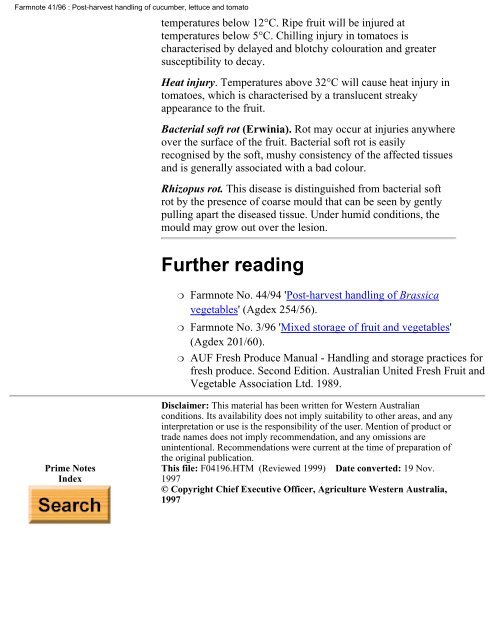Post-harvest handling of cucumber, lettuce and tomato
Post-harvest handling of cucumber, lettuce and tomato
Post-harvest handling of cucumber, lettuce and tomato
You also want an ePaper? Increase the reach of your titles
YUMPU automatically turns print PDFs into web optimized ePapers that Google loves.
Farmnote 41/96 : <strong>Post</strong>-<strong>harvest</strong> <strong>h<strong>and</strong>ling</strong> <strong>of</strong> <strong>cucumber</strong>, <strong>lettuce</strong> <strong>and</strong> <strong>tomato</strong><br />
temperatures below 12°C. Ripe fruit will be injured at<br />
temperatures below 5°C. Chilling injury in <strong>tomato</strong>es is<br />
characterised by delayed <strong>and</strong> blotchy colouration <strong>and</strong> greater<br />
susceptibility to decay.<br />
Heat injury. Temperatures above 32°C will cause heat injury in<br />
<strong>tomato</strong>es, which is characterised by a translucent streaky<br />
appearance to the fruit.<br />
Bacterial s<strong>of</strong>t rot (Erwinia). Rot may occur at injuries anywhere<br />
over the surface <strong>of</strong> the fruit. Bacterial s<strong>of</strong>t rot is easily<br />
recognised by the s<strong>of</strong>t, mushy consistency <strong>of</strong> the affected tissues<br />
<strong>and</strong> is generally associated with a bad colour.<br />
Rhizopus rot. This disease is distinguished from bacterial s<strong>of</strong>t<br />
rot by the presence <strong>of</strong> coarse mould that can be seen by gently<br />
pulling apart the diseased tissue. Under humid conditions, the<br />
mould may grow out over the lesion.<br />
Further reading<br />
❍<br />
❍<br />
❍<br />
Farmnote No. 44/94 '<strong>Post</strong>-<strong>harvest</strong> <strong>h<strong>and</strong>ling</strong> <strong>of</strong> Brassica<br />
vegetables' (Agdex 254/56).<br />
Farmnote No. 3/96 'Mixed storage <strong>of</strong> fruit <strong>and</strong> vegetables'<br />
(Agdex 201/60).<br />
AUF Fresh Produce Manual - H<strong>and</strong>ling <strong>and</strong> storage practices for<br />
fresh produce. Second Edition. Australian United Fresh Fruit <strong>and</strong><br />
Vegetable Association Ltd. 1989.<br />
Prime Notes<br />
Index<br />
Disclaimer: This material has been written for Western Australian<br />
conditions. Its availability does not imply suitability to other areas, <strong>and</strong> any<br />
interpretation or use is the responsibility <strong>of</strong> the user. Mention <strong>of</strong> product or<br />
trade names does not imply recommendation, <strong>and</strong> any omissions are<br />
unintentional. Recommendations were current at the time <strong>of</strong> preparation <strong>of</strong><br />
the original publication.<br />
This file: F04196.HTM (Reviewed 1999) Date converted: 19 Nov.<br />
1997<br />
© Copyright Chief Executive Officer, Agriculture Western Australia,<br />
1997




![Section 4 [ PDF file, 252 KB] - The Field Alliance](https://img.yumpu.com/51387260/1/158x260/section-4-pdf-file-252-kb-the-field-alliance.jpg?quality=85)












